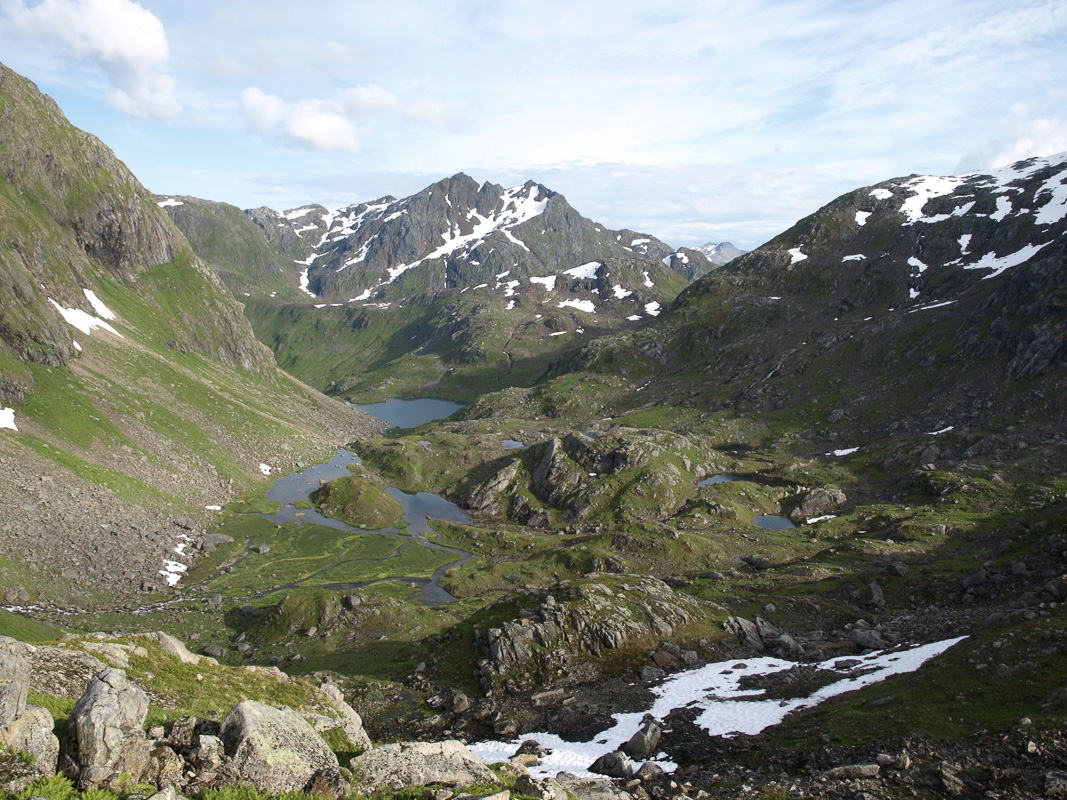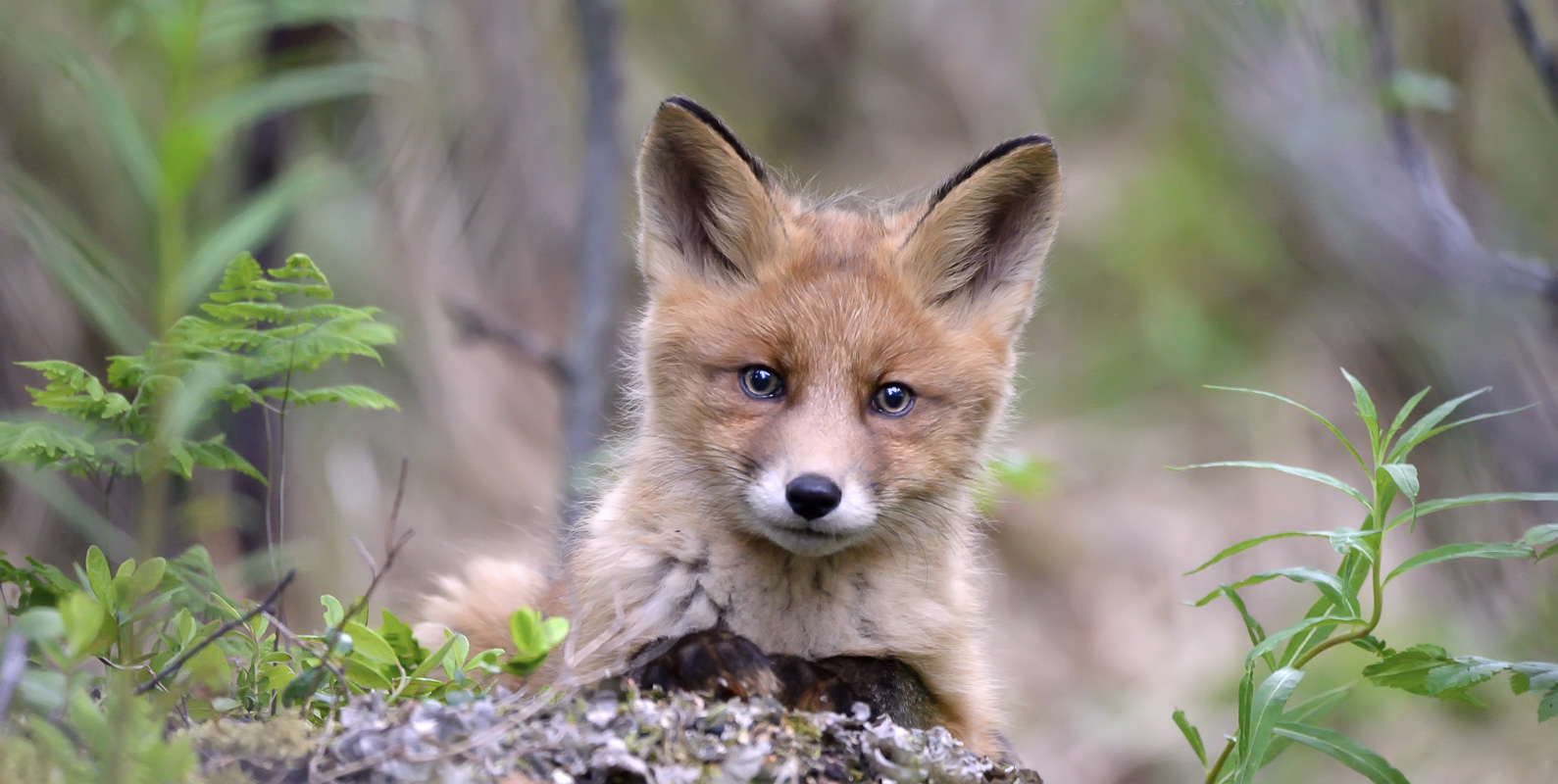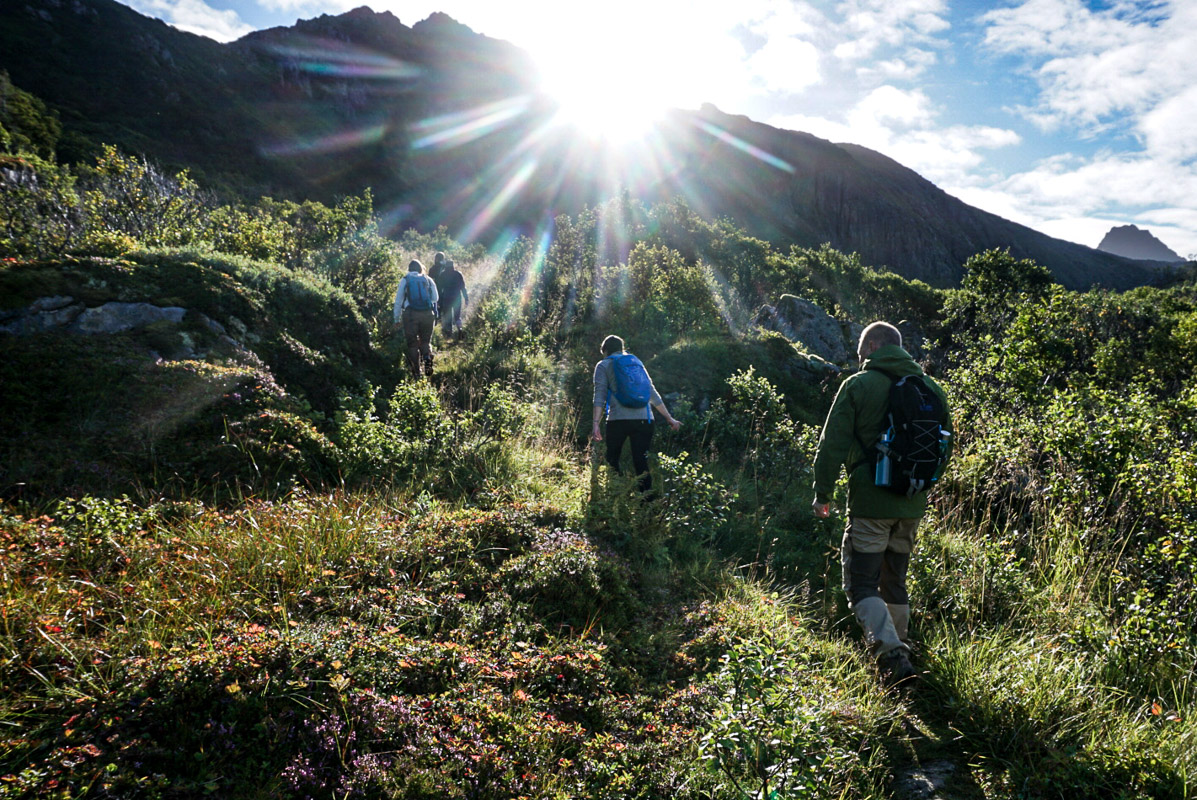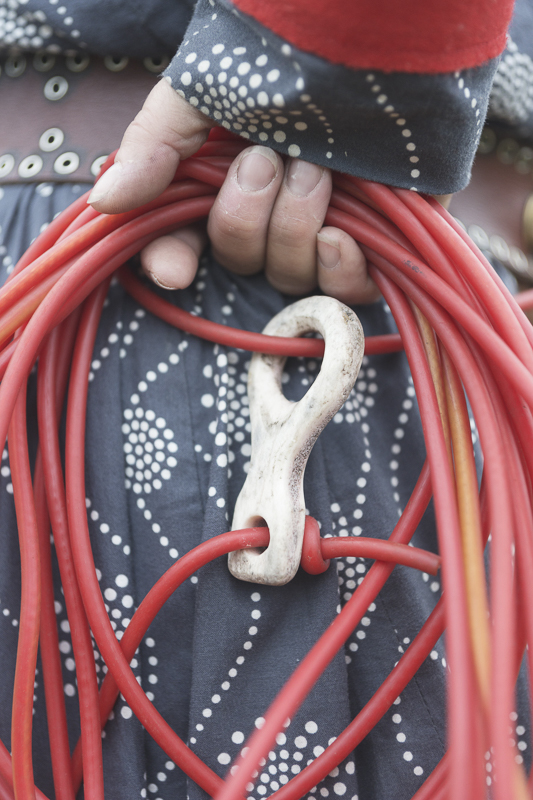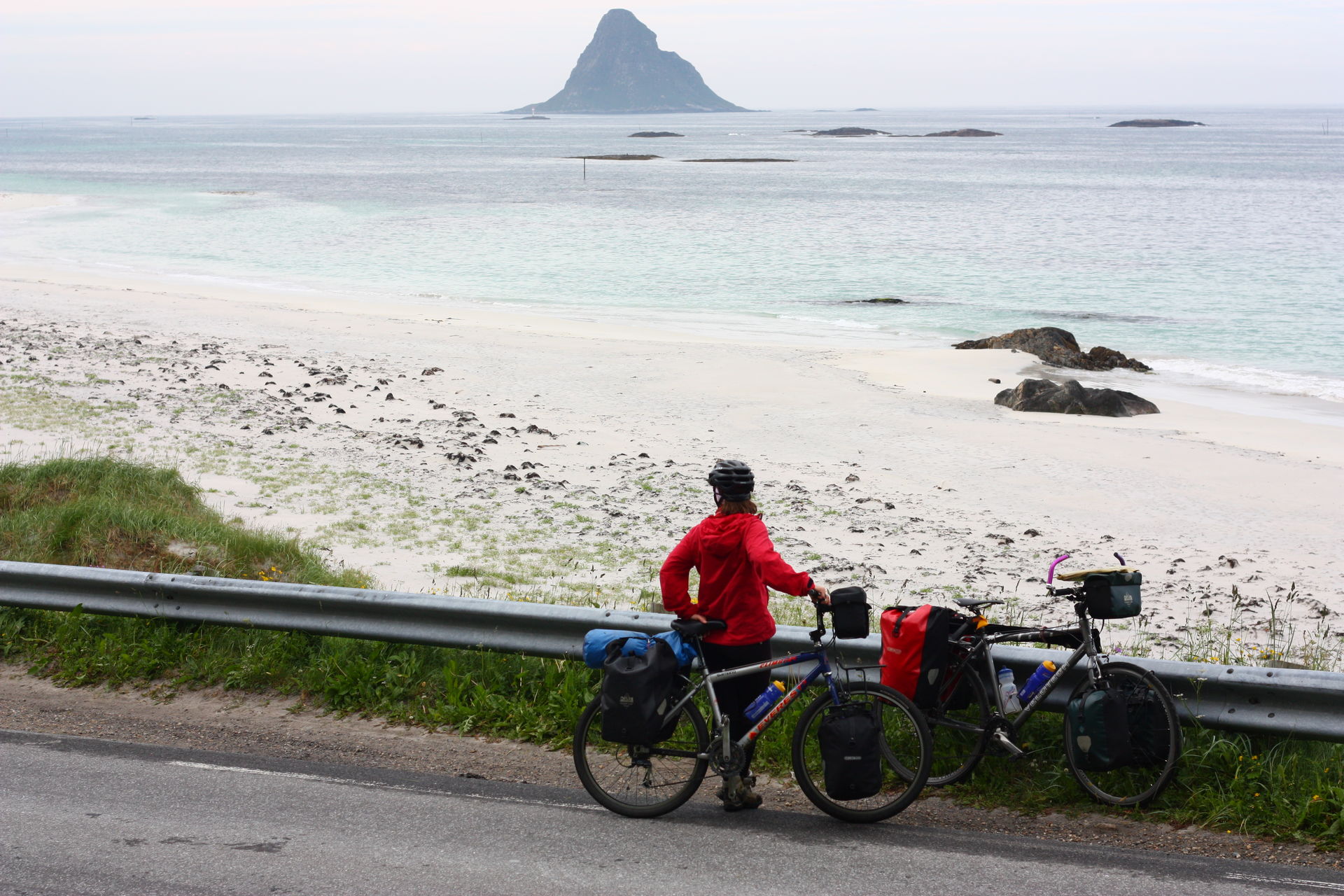The sea off Vesterålen is maybe the richest in the world, attracting whales, seals and seabirds. Human habitation is also based on the riches of the sea. But behind the rugged, rocky coast, there is green farmland, lively towns and villages, green forests and towering mountains. Slender bridges tie the islands together with their elegant spans.
Glenn is the biggest of the sperm whale bulls off Andenes
Off Vesterålen, there is hardly any continental shelf. Instead, the seabed drops directly into the deep ocean just offshore. The meeting of cold and warm waters means the sea is rich in microorganisms, plankton, and fish. Bigger predators, like bird, seals and whales feed on these rich seas. Sperm whales, the biggest toothed whales of them all, hunt for giant squid at a depth of 1000 metres. The population of sperm whales are all oxen, as the cows are found around the Azores. Glenn is the name of the biggest one, when he’s around, the other boys stay away. From Stø and Andenes, you can go out at sea, and be almost certain to meet these giants of the sea. One is hardly surprised to see orcas, white-nosed dolphins, minke whales and other species, but they don’t turn up with the same regularity.
Sea birds feed on the rich ocean
The rich marine life is also highly visible at the numerous bird cliffs along the coast. Bleiksøya off Andenes and Anda off Stø are the biggest ones. Puffins, guillemots and razorbills fly frantically with their short wings with small fish in their beaks, skuas harass them and steal it, and white-tailed eagles sail on strong wings high up there, ready to strike. Gannets have problems taking off from the water after overeating, and cormorants dry their feathers on the rocks. The coast is so busy in summer, you can hear the noise from afar.
Vesterålen’s fishing villages have their own personality
The fishing communities along the Vesterålen coastline are as varied as they are picturesque. Andenes, one of the oldest fishing communities along the whole coast, has turned into a busy little town centred around its iconic lighthouse. Myre is another modern place exuding business. Stø, on the other hand, is a haven for traditional fishing culture, and fishermen go out in small boats and dry their fish on big racks. If you walk along the sheltered port at Nykvåk in Bø, you also see plenty of small vessels going out every morning straight into the open Atlantic.
Old fishing villages get a new lease of life
Nyksund was once a hub of activity, attracting seasonal workers from all over the archipelago. After World War II, however, the perfectly protected harbour got too narrow for bigger, more modern ships. People started to move away, and by 1970, the colourful houses were left alone to fight the winter storms. By accident, people on the look for a place to relax and think, started to restore the houses. Today, prams are again observed in Nyksund. There is no fishing anymore, just yoga, good food and art studios. Skipnes is another old centre that was lost in time, and it can be visited in summer for people looking for pure relaxation and beautiful coastlines.
Along the inner waterway, the land is green and fertile
Today, you find most people along the inner waterway in Vesterålen, the one that gave the archipelago its name; roughly translated into “the western waterway”. Protected by the mountains, one can raise cattle and sheep and grow potatoes on flats along the waterways. Further up, light, green birch forests clad the hillsides. All this greenery is framed in by majestic mountain peaks in the east and south.
The busy towns are the hub of activity in Vesterålen
Three major towns are found here, Sortland, Stokmarknes and Melbu. Sortland, the biggest town, is known for its art project, “the blue city”, in which most downtown houses have been painted blue. In Stokmarknes, one can soon visit the new Hurtigruten museum. Outside the historic church of Hadsel, there is the “arctic Stonehenge” – an iron age obelisk places exactly where the first rays of the sun shine at its return after the Polar Night. At Melbu, the Melbu Manor is a stately home from the early industrialisation. One of the fish oil tanks at the dock has been turned into a concert venue with its fantastic acoustics.

Planning to visit Vesterålen?
Visit Vesterålen assists you with activities and attractions in the region and islands of Vesterålen.
Hurtigruten was born in Vesterålen
Industrious and creative people, the Vesterålians were pioneers in modern communications. In 1893, the tradesman and sea captain Richard With was tired of slow und unreliable ship passages to the south. He started a new company, sailing day and night, only stopping at the major centres. Trondheim-Bodø was a mere day’s sailing, and Tromsø followed the next day. Awed by the speed, people on the coast promptly baptised the shipping line Hurtigruten – the fast route. In 1922, the narrows of Risøyrenna were dredged, and Hurtigruten could sail unobstructed through the heart of the green archipelago. Today, you can see Hurtigruten dock and Risøyhamn and Sortland, and at Stokmarknes the vintage Hurtigruten ship Finnmarken is caged in glass. Of course, you see the modern ships of the legendary shipping line plowing the waters of the inner
Northern Lights can be seen in mild climates
The Northern Lights Oval passes 100 km above Vesterålen. This means that Vesterålen is an excellent location to observe this celestial phenomenon. The islands also enjoy the mildest winter climate on their latitude, meaning that you can observe the lights and freeze less than elsewhere under the Northern Lights oval. The rugged landscape of cliffs, mountains, elegant bridge spans and towering peaks forms a dramatic backdrop for the Northern Lights, unless it appears over the ocean in the northwest. Of particular interest is the Space Ship Aurora, located near the rocket shooting range at Andøya
The Midnight Sun shines for two months
Vesterålen enjoys the rays of the Midnight Sun for around two months in the summer. The light is very low, however, so you can’t see the eye of the sun everywhere. Go onto the Sortland bridge, find yourself a nearby mountain or seek out a location on the outer coast with unobstructed sea views. On a bright summer night, you can also go moose-hunting with your camera, as the wildlife is more active when humans slow down.
See Vesterålen from a mountain top
Vesterålen’s topography is entertaining, yet not as inaccessible as you should think. A number of marked trails lead up to fantastic viewpoints. From Vetten, a 2-3 hour hike, you have endless seaviews, you see iconic islands and the Lofoten chain from the less viewed northern side. The Måtinden near Andenes is short and brutal, and rewards you with the view of the conic Bleiksøya Island and the rugged outer coast. The most commanding view, however, is from the highest point of the archipelago, the 1264 metre Møysalen peak. From here, you see far beyond Vesterålen to Sweden’s highest peak, Kebnekaise. If a 10 hour hike isn’t your idea of fun, you of course go for the easiest of the 200 hikes or so that Visit Vesterålen lists up.
The Queen’s Route follows the coastline
One of the most iconic hikes goes between two fishing villages, the abandoned and revived village of Nyksund and the traditional village of Stø. On the way, there is plenty of uphill and downhill, fabulous views and unobstructed horizons. The coastal path in Bø is shorter, less hilly and takes you very close to the roaring ocean. Hiking is not all about mountains in Vesterålen.
The Trollfjord is a gem at Vesterålen’s southern gateway
Many people’s first impression of Vesterålen is the short and narrow fjord of Trollfjorden, at its southern extremity. The Hurtigruten sails into it in the summer, to experience the dark, silent waters under the 1000 metre high, majestic peaks. The Hurtigruten makes a u-turn, and continues the Raftsundet waterway, in a landscape of dark, hard, old rocks and peaks with only scattered farms along the shore.
Experience art in a wild and rugged landscape
Since before the Viking age, Vesterålen was part of an international trade network, bringing international impulses up the coast to the islands. Today, the well-educated and well-informed inhabitants of Vesterålen also appreciate the lighter side of life. Galleries like in the old manor building at Jennestad, the challenging artworks involved in the Artscape Nordland project, the blue city project of Sortland, benefit from the particular light and landscape found in the archipelago.
Where do you eat well in Vesterålen?
Vesterålen’s close contact with the sea means this is the best place possible to eat fish. At Smak Vesterålen, a food festival covering the whole of the archipelago, you can taste traditional cuisine based on fish and mutton. There is also a fair bit of fine dining, notably in Andenes, Sortland, Nyksund, Stokmarknes and Melbu. They serve up a fine mix of local fish and international spices and condiments, or just the fine version of grandma’s old cooking. Against which of course nothing compares. A speciality to look out for, is Arctic char, the little brother of salmon and trout. More tender than its bigger relatives, it is served in every eatery.
Norwegian Scenic Route on Andøya runs metres from the Atlantic
The route from the northern tip of Vesterålen along the outer coast is a meeting between rock hard cliffs and the forces of the Atlantic. The road meanders along sandy beaches, tight-knit fishing villages, rocky outcrops and bogland. This route is one of the 18 designated Norwegian Tourist Routes, meaning it has architecturally designed parking lots, viewpoints and facilities.
Reindeer graze in Vesterålen’s mountains
Above the forests, coasts and fishing villages there is a secret Vesterålen, the grazing land of reindeer. Some Sami families keep their reindeer above the treeline, where there is nutritious grass and moss. When you hike in the mountains, you see reindeer everywhere. Some places, you can also visit Sami families, have coffee in the lavvu (tent) and listen to the joiggus (joik), the Sami chant.
Go explore the backwaters of Vesterålen
Vesterålen is by far not overran by tourists. However, even here, exploring the little routes makes the visit so much more worthwhile. Drive through the Bø tunnel to the least visited of the parishes in Vesterålen, take a right and arrive at Hovden. Park you car, wander under the fishr acks and past the solid breakwater and sit down to look at the endless horizon. A slow drive on country roads along the western side of the Hadseløya shows friendly greenery up close and majestic mountains afar. The drive from Sigerfjord to Hennes goes along Vesterålen’s sunniest coast to the foot Vesterålen’s roof, the 1264 metre high Møysalen (“Maiden’s saddle”). The boatride from Myre to the western archipelago is a meeting with everyday life in a very remote corner of Vesterålen.
Stop at the little museums and attractions in Vesterålen
The independent traveller exploring the sidetracks should take time to stop at little historic places and attractions. Not because they will ever make it to any top ten attraction list, but because they tell stories seldom heard. The local museum at Jennestad is simply an old-world store, complete with replacement coffee and fish skin shoes from WWII. The Bø Museum is inspired by traditional fairy tales. The Neptune in Melbu is an old, rusty fish factory. In Alsvåg, an unbelievably long traditional farmhouse houses exhibits about local history. In Andenes, you can get a guided tour to the lighthouse. Totally different is the Aquaculture Vesterålen, explaining the ins and outs of modern salmon farming.
Spring is the time for backcountry skiing
In the far east and south of Vesterålen, mountains rise more than 1000 metres from the fjords. This landscape of needle-shaped peaks and deep valleys is a challenge to experience backcountry skiers. December and January are too dark for most, and the snow cover can be iffy. But from February to May, perfect conditions can be more or less guaranteed.
Where do you sleep well in Vesterålen?
Weathering out a winter storm at Litløy Lighthouse is for people in need of no entertainment but the endless changing of the sky. The most typical accommodation in Vesterålen are locally run holiday homes with self-catering facilities, either spread in a forest or on the dockside in a fishing village. For families and groups of friends, they are both comfortable and affordable. The small towns of Vesterålen have both the comfortable chain hotels, locally owned hotels with a bit of history and some good budget options.
When should you visit Vesterålen?
Until now, everyone has come in the Norwegian summer holiday. This is when the Midnight Sun shines, when the snow in the mountains has melted and when all museums and attractions are staffed with guides. The autumn is a favourite among the locals to go mountain hiking in autumn colours, and the first Northern Lights are visible in late August. November to January is the time of the Polar Night, with very short days and long evenings perfect to watch the Northern Lights. In late January, the days are noticeable longer, and the snow cover in the mountains is more stable. This is the time for outdoor adventure, such as cross country and backcountry skiing, dog sledding and snowshoeing. Also, the winter fishing is in full swing, bringing busyness and temperature to the fishing villages, and many good cod meals on your plate. In April, the northern lights are on the wane, but days are long and sunny, spring is felt in the lowlands and winter still reigns supreme in the mountains. May is also a good month to sightsee, with very few tourists and good weather.
Vesterålen has the Midnight Sun for two months
The archipelago of Vesterålen enjoys the rays of the Midnight Sun from late May to late July. In Vesterålen,you have the chance to see the Midnight Sun over the Atlantic, with only a tail of a whale to break the horizon or the birds to break the silence.
Planning in Vesterålen
Vesterålen is a region, or a group of islands, in Northern Norway. It is the northermost region of Nordland county, and as such in the middle of Northern Norway, some 300 km north of the Arctic Circle.
You can fly. There are two airports, Skagen near Stokmarknes and Andenes, both mostly used by smaller aircraft. Many people land in Harstad/Narvik Airport Evenes, and drive or take the bus to Sortland before fanning out across the archipelago.
Yes. In fact, you can go here without any ferries, as bridges connect the islands with each other and the mainland. If coming along the E6, you can save time by taking the Bognes-Lødningen ferry, though. If you come up through the Lofoten Islands, the ferry Fiskebøl-Melbu connects Svolvær with the towns in central Vesterålen. A summer ferry from Andenes to Senja gives a rather quick
Hurtigruten sails to Vesterålen, the birthplace of this famous shipping line. It calls at Stokmarknes, Sortland and Risøyhamn.

Planning to visit Vesterålen?
Visit Vesterålen assists you with activities and attractions in the region and islands of Vesterålen.







